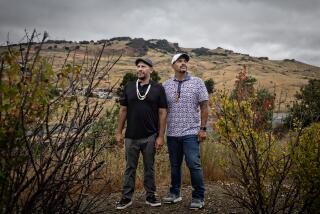Prizes Put Squeeze on Bingo Halls
- Share via
Juicy inducements of prizes totaling up to $27,000 a night at giant bingo palaces in the San Fernando Valley have wooed players away from smaller operations, squeezing many church, school and senior-citizens’ groups out of the game, city officials say.
Yet city records show that until the smaller groups--those attracting fewer than 200 players at a time--bowed to competitive pressure for more and larger prizes, they traditionally gave a larger share of bingo proceeds to their charities.
This year, the four largest bingo parlors in Los Angeles--all of which were in the Valley until one was shut down for irregularities--gave an average of 7% of their gross revenue to charity, while smaller Valley organizations averaged 12%, according to monthly reports filed with the city. Robert Burns, general manager of the city’s Social Service Department, said growing pressure to match large prizes dragged the citywide percentage of profits for charity down from a peak of 23% in 1979.
“They have put the squeeze on others and on themselves,” Burns said of the larger operations. “The basic problem from my perspective is the declining profits to charities.”
The four giant operations that dominated the Los Angeles bingo scene in the Valley during the past year were Identity, a benefactor of physically disabled children; United Cerebral Palsy; the Latin American Civic Assn. and the United Funding Organization, which closed in June after city inspectors discovered it was skimming profits.
Those large organizations have averaged between 250 and 600 players a night and have handled up to $450,000 a month in gross revenue.
The loophole in the 1976 state law permitting bingo, critics said, is that it requires no set percentage returns for charity, allowing the overall earnings from bingo in Los Angeles to decline from a high of $4.9 million in 1984 to $4.7 million last year, while total money played in the games rose from $30 million to $41 million during that same period.
Such organizations as churches, schools and senior-citizens’ groups that had to give up on bingo have been forced to find other sources of money. Toward the end of their bingo ventures, officials from those groups say, hefty prizes and mounting expenses consumed the money wagered and sometimes even cut into the charities’ pocketbooks.
Valley Beth Israel in Sun Valley lost more than $8,000 in the five months that ended in February, when it stopped holding weekly bingo games after 10 years of offering the game.
“It put our synagogue in quite a hole,” said Abe Gelfand, former bingo manager for Valley Beth Israel.
The synagogue was not alone. In the past two years, 16 small Los Angeles bingo games closed, 10 of them in the Valley, according to a city report. All of them blamed increased competition.
Only the small games that have a regional monopoly or a loyal clientele have managed to stay afloat while keeping their prize values down, Burns said. The best example in the Valley, he said, is the Congregational Church of the Chimes, which averages about 100 players at weekly sessions and holds on to about a third of its revenue--up to $3,000 a month.
Keeping Stakes Low
“We’re not in competition with those high games. People who come to our games are not heavy spenders,” said Janette Ross, a church volunteer. “We’re just a very low-key but friendly game.”
Ross said parishioners are drawn to the church’s bingo events not so much by gambling but by social opportunities. For that reason, the church views the games as community gatherings.
“We don’t want to give higher prizes and attract that kind of clientele. Ours is more for entertainment and church outreach,” she said. “As a church, we wanted to be absolutely above reproach because it was a little delicate for a church to approve this.”
As a result of the lower-key approach, the church’s bingo events have amassed a small but loyal following of parishioners.
By contrast, Burns said, Valley Beth Israel may have faltered by making “an effort to stay in the hunt.” When the gigantic Latin American Civic Assn. opened in Van Nuys in 1986 and started holding bingo on the same night as Valley Beth Israel, the smaller organization raised its prizes from $100 a game to the $250-a-game state maximum. To cover the added costs, Valley Beth Israel had to reduce the amount that went to the synagogue’s school.
Monthly reports filed with the city show a peak for the synagogue’s bingo money-raising efforts in September, 1986, when it managed to keep more than $5,000--13% of gross revenue. By mid-1987, nearly all of the playing money was going to prizes.
Competition Blamed
Gelfand attributed the decline to fierce competition from the Latin American Civic Assn., which quickly became the third-largest bingo operation in the city and now holds second-place to Identity in Woodland Hills.
“From the day it opened we didn’t make a dime because we couldn’t meet the competition,” Gelfand said. Despite the last-ditch effort of larger prizes at Valley Beth Israel, he said, the number of players per session dwindled from 185 to 135 players.
As head of Identity, Los Angeles’ largest bingo operation, Edith Ryan often is painted as the villain on the bingo circuit. Identity sees more money in one night than most small organizations see in a month. It opened in 1983 and in the past year an average 9.7% of the monthly gross revenue was left over for the physically disabled children that Identity supports.
But Ryan said it is unfair to single her out. She blamed the small bingo closures on the proliferation of Indian reservation bingo in Riverside County and on the former United Funding Organization of Sun Valley.
“It’s not true. We didn’t do it,” she said. “It wasn’t the size of it, but how somebody was running bingo. . . . They were the ones giving away cars for door prizes. They were the ones with free buffets with carvers carving roast beef.”
Overhead Cited
Ryan said she only increased her top prizes to the legal limit of $250 a game after another top bingo operation--United Cerebral Palsy/Spastic Childrens Foundation--raised theirs. She also said she would like to have more money left over for her charity, but overhead costs have prevented that.
Representatives of charities that said they were forced out have gone back to their old methods of fund-raising, such as bake sales, telethons, award dinners and swap meets. Valley Beth Israel was the only one of those contacted that indicated it would try bingo again under player and game limits approved last week by the Los Angeles City Council.
Father Sean Flanagan of St. Catherine of Siena in Reseda echoed the bingo-weary tone of many of the smaller charities. This past year, the church replaced bingo with candy drives, magazine drives and an annual carnival, which suits Flanagan just fine because, he said, “I personally do not like bingo” or any other form of gambling.
Profits Dwindled
But Flanagan recalled that when he arrived at the church in 1983 “bingo was going great guns,” with about $14,000 a year going into church school coffers--about 40% of bingo’s gross revenue. During the next four years the school’s bingo spoils dwindled to an annual low of $5,200 in 1987.
Bingo was phased out at St. Catherine in October, 1987, and Flanagan said he had no doubt “that the big professional-type bingo operations were wiping out the little outfits” like his.
The reason the large bingo operations exist is a matter of dispute.
They say they want to raise money for charity just like anyone else. For Ryan, at Identity, the driving force was caring for her stepson who had a head injury. Through his teachers, she discovered that there is little or no support for those who are injured, but not retarded or sick in other ways. After trying in vain to garner federal support, she turned to bingo.
“To do a good job, instead of just telling them where to get the work done, we’re talking about a high-volume cost,” she said. “Wheelchairs, artificial arms and legs that can cost up to $7,000 each, physical therapy is quite expensive.”
Such bingo critics as Los Angeles City Councilwoman Joy Picus suspect a profit motive, even though state law does not allow salaries to come out of bingo earnings.
“I am certain those who run what I consider not entirely legitimate operations are in some way benefiting,” Picus said. “Whether they’re skimming it off the top in some way, I just don’t know. . . . I am certain that anybody who wants to find ways to cheat the city can do that more easily than we can find it out.”
It was the proliferation of large-scale Valley bingo parlors that formed the impetus for the legislation passed by the Los Angeles City Council last week to limit the number of people and games played, Burns said. Councilman Ernani Bernardi, who sponsored the bingo rules, visited the United Funding Organization game last year. He was appalled at the legions of players--often 600 or more a session--and the quantity of money changing hands.
As he said after Tuesday’s unanimous vote, “We were turning the city into a Las Vegas-type of casino operation with regard to bingo.”
Although the city restrictions--350 players a game and 40 games a session--will not prevent large games, Burns and the council members said they hope the rules will prompt the biggest operations to become more moderate in their prizes, which would allow smaller groups to compete again for players.
Of the remaining giant bingo operations, Identity opposed the regulations, but United Cerebral Palsy supported them because they too have felt the sting of increased competition for bingo dollars. Repeated calls to the Latin American Civic Assn. were not returned.
Like Ryan at Identity, Richard Miler, the chief financial officer at United Cerebral Palsy, said it was the proximity and size of the now-defunct United Funding Organization games that hurt his group the most. He thinks that the city rules limiting the size to 350 people will prevent another bingo palace of its size from opening.
“They were killing everybody,” Miler said.
United Cerebral Palsy watched its earnings for charity drop from a 1986 monthly average of $32,200--15% of revenue--to a 1988 monthly average of $8,600 or about 4% of revenue. Miler said charity earnings have begun creeping back up during the three months since United Funding Organization closed.
More to Read
Sign up for Essential California
The most important California stories and recommendations in your inbox every morning.
You may occasionally receive promotional content from the Los Angeles Times.










